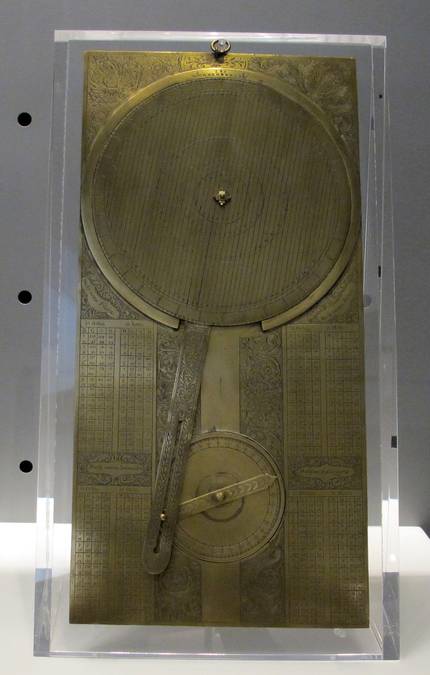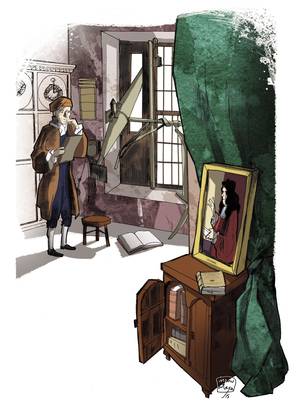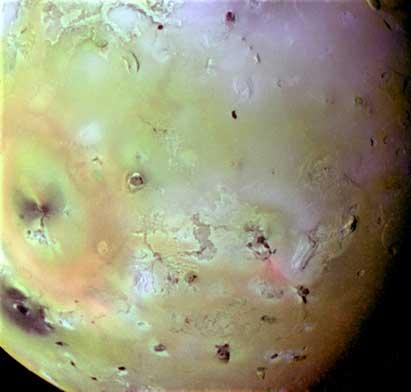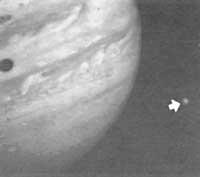Io and the speed of light
2020/04/29 Galder Gonzalez Larrañaga Iturria: Elhuyar aldizkaria
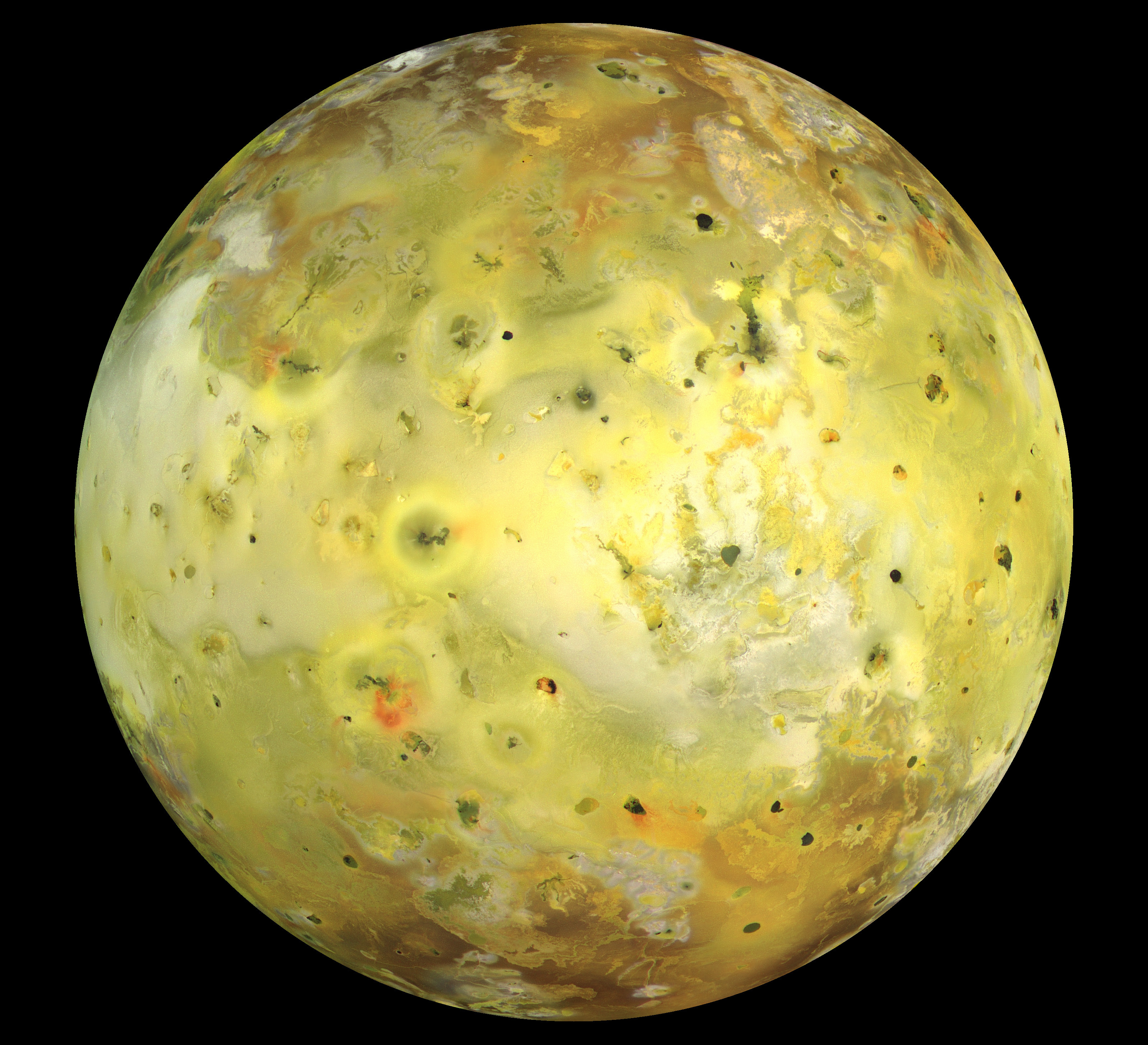
Celatonea in mind and travels the world
Since 1956 Arnold Nawrocki introduced the cheeses processed in individual plastics [1], it is easier to measure the speed of light at home with a microwave and a ruler [2]. At the time of Galileo, however, the speed of light was an unknown concept.
September, 1617. Galileo Galilei, one of the most famous astronomers in history, is tied in a chair inside a small boat located in a pool located on top of a boat located in the port of Livorno. In the head there is a curious apparatus invented by him, the celatone [3].
Celatonea is one of those devices extracted from a steampunk comic, a helmet with glasses and a telescope in one of the eyes. In later versions there is a candle above to read or write at night. Its function is also very concrete: once Jupiter is located with the eye without a telescope, we can see the planet from the eye with a telescope, which allows us to observe with great precision when the eclipse of one of the satellites of Jupiter occurs. Since the movement of the observer and, in particular, that of the ship will cause problems to see Jupiter, the observer must be placed on a floating chair [4,5].
Seven years earlier, on January 7, 1610, Galileo saw Jupiter, for the first time from Pisa, with a telescope of his work. Next to Jupiter he found three stars (fourth at night) in a curious straight line. The following night he reobserved Jupiter and discovered that these three stars moved, but against the direction that could be thought of the Earth's movement. That same night, far from Pisa, Simon Marius also observed Jupiter and commented on the location of the four points that were next to him. In the coming days two scientists, each on their side [6], described the movement of these stars and understood that they were the satellites of Jupiter. This had important consequences: if Jupiter had a complete system revolving around it, the heliocentric theory of Copernicus could be considered proven [7]. We attribute the discovery of satellites to Galileo, who was the first to publish it, but the truth is that we use the names proposed by Marius: Io, Europe, Ganymedes and Calisto [8].
From 1612, with a lattice system devised by Galileo himself, he began to accurately measure the position of the satellites. He soon discovered that the velocity of the satellites was proportional to the distance of Jupiter and that, by making tables, it was possible to know the exact position of these satellites. In particular, because it was possible to predict the eclipses of each satellite and thereby measure time. The satellites of Jupiter, and especially Io, as we will then see, were astronomical clocks; and if we have a clock, we can solve the problem of length.
The problem of length
Imagine you're traveling the Atlantic Ocean on a boat, let's say the XVI. That for the twentieth century you want to know what your position is, especially so that nothing costs you. To know what your position is you will need two numbers: latitude and longitude. Latitude is relatively easy to calculate: You can measure how much the sun rises at noon above the horizon and calculate where you are according to the day of the year. At night, even easier: with the position of the stars and the relative height you can make the same calculation, without having to wait at noon.
But… how to calculate the length? It is not possible. The usual way is to count the number of knots that fall in thirty seconds after throwing a rope with knots on the sections of a stroke from the boat to the water. This measure is still called knot. Then, on a map, using a compass, you can mark these knots in the direction that the boat has and know how much we moved about the previous position. It must not be said: it is not a very precise method, and not only money, but also life was lost as a consequence of that inaccuracy [9].
This problem was called “the problem of length” and the nautical power of each epoch has offered a lot of money for those who found a solution. When Galileo thought to use Io as a fixed clock, Spain was the marine power and Philip III the prize. But twenty years after Philip III offered the prize, he received Galileo's proposal and, apparently, his secretaries responded by saying it was not a practical method. It was nothing useful.
Galileo's proposal demanded at least three things: A sailor with celatone to observe the eclipses of Io, a table of anniversaries that defined the eclipse or, better still, a jovilabium (a calculator that determined the positions of the satellites, realized with several mobile pieces [10] —see image—) and, finally, a pendulum clock. The logic was that this jovilabium made in Pisa tells us when the eclipses of Io in Pisa are perceived with total precision. In the boat, if we measure when an eclipse is, the time difference will depend on our latitude. For example, if it occurs 2 hours later, taking into account that the day has 24 hours and the world 360º, we will calculate that we are 30º from Pisa (since 2/24×360º = 30º).
A while later, he tried to sell the same method to the Netherlands, with some technical improvements: the celaton carrier should float between two separate oil spheres in an oblique seat [11]. He did not get it for practical reasons: Jupiter cannot be seen during the day, in the middle of the nights of the year it cannot be detected and when it can be detected it can be in the cloud, the ships move, the sailors did not have such precise technical knowledge and, perhaps most importantly, a clock with pendulum does not work on a moving boat.
Ioren dantza inaccurate
But Galileo's method had great value on earth. Unlike a boat, this method was very useful on land to determine its length. Maps of the world were redrawn with the most concrete measures ever taken: the seas increased and most countries were reduced. Under the direction of Cassini, France made measurements of great precision and realized that its area was inferior to that of the maps. They say that Louis XIV declared that he lost more territory because of astronomers than because of his enemies.
Let's go to the goal of this story. However, Cassin realized that Io's orbit was not accurate and attributed the error to the eccentricity of the orbits. Cassini sent astronomer Jean Picard to Tycho Brahe's observatory to analyze the accuracy of measurements. In it collaborated Ole Rømer, the last protagonist of our story.
We have lost most of Rømer's data, which were burned in the Copenhagen fire in 1728 [12]. But we know that between 1668 and 1678 he observed eclipses thanks to an unburned paper and a letter sent to Christian Huygens [13]. Rømer realized that the hour of eclipses varied according to the position of the Earth on Jupiter: when they were in conjunction, far away, eclipses were produced later than expected, and when they were in opposition, near, before prediction. This change, moreover, was progressive and depended on the distance between Earth and Jupiter [14].
The only solution was that the light took time to reach Earth from Jupiter, so the farther away Jupiter was, the later the eclipse occurred. On August 22, 1676, before the Royal Academy of Paris, the speed of light is mentioned for the first time:
“The second inaccuracy is due, apparently, to the fact that the light coming from the satellite takes a time to arrive; it seems that it takes between ten and eleven minutes to travel the half-diameter distance of the earth’s orbit.” [15]

Today we know that that time is not ten to eleven minutes, but 8 minutes and 13 seconds. We also know that the distance Earth-Sun is 149.6 million kilometers, but in Rømer times this data could not be calculated properly. Huygens used Rømer's data to calculate that the speed of light was 220,000 km/s, 26% lower than the actual value [16]. A century later, astronomer Jean Baptiste Joseph Delambre made another calculation using Io, according to which the light took 8 minutes and 12 seconds to arrive from the Sun to the Earth, very close to the actual amount [17].
Through the curves of science
I think I read Richard Dawkins, speaking of the term God of the Hollows, every time a scientific response is found two other gaps arise. But I left the book to someone and now you can't find the exact reference. It serves to explain the conclusion that every time science finds a response, it finds new ignorance that opens an unknown path. We cannot predict where we are going to get there because the new questions are not written.
When Galileo studied the precision of Io, he did not want to find the speed of light. It has been a lateral damage. In the last years of his life, persecuted by the Church, Galileo remained closed in his house. With the use of the telescope he dedicated himself to improving semi-blind, pendulum and celatone watches, thinking that he would achieve a prized prize before dying. Four hundred years later Io appears in the series The Expanse: when a message is sent from her, the time that takes light on the screens of these fictitious carnivals appears again and again. It is possible that one day the man arrives at Io; if it happens, they will have to know what is the latitude and longitude for their juxtaposition, even to exploit the precious mineral award that is in the place.
References References References References
1 The Associated Press (12-07-2003) «Arnold N. Nawrocki, Cheese Innovator, 78» The New York Times ISSN 0362-4331.
2 Chestnut trees, E. «How to measure the speed of light at home?» Lidia with Chemistry 16-11-2015 . Date of inquiry: 09-01-2020.
3 Drake, S. (1995) Galileo at work : his scientific biography (Dover ed. Edition) Dover Publications ISBN 0-486-28631-2 PMC 32508102.
4 Ayala, L. (2010). Surpassing human nature: Reinventions of and the body as a consequence of astronomical experiments in the seventeenth and eighteenth centuries. Metaverse Creativity, 1(1), 101–113. fair:10.1386/mvcr.1.101_1
5 Galilei, G... (2012) Le opere di galileo galilei. Nabu Press ISBN 1-286-54512-9.
6 Pasachoff, Jay M. (May 2015). “Simon Marius’s Mundus Iovialis: 400th Anniversary in Galileo’s Shadow”. Journal for the History of Astronomy. 46 (2): 218–234. Bibcode:2015JHA...46..218P. just:10.1177/0021828615585493
7 Galilei, G, Sidereus Nuncius
8 Marius/Schlör, Mundus Iovialis, 78. Page Page Page
9 Possibility to read more about this section: Sobel, Dava (D.L. 2012) Length: the true story of a solitary genius who resolves the greatest scientific problem of his time Ehu Press ISBN 978-84-9860-745-1 PMC 864229958
10 Bedini, S. A. A. (1986). “The Galilee jovilabe”. Nuncius. 1 (1): 24–26.
11 “Apparatus to render a telescope manageable on shipboard” in «Papers of the Board of Longitude : Papers regarding inventions and improvements of various astronomical and nautical instruments» Cambridge Digital Library
12 Meyer, K. (1915), “Om Ole Rømers Opdagelse af Lysets Tøven”, Det Kongelige Danske Videnskabernes Selskabs Skrifter, 7. Other eating habits 3.
13 Rømer, O. (September 30, 1677), “Lettre No.2104”, in Bosscha, J. (eds). ), LO uvres complètes de Christian Huygens (1888–1950). Take VIII: Correspondance 1676–1684, The Hague: Martinus Nijhoff
14 Cruikshank, D. P.; Nelson, R. M. M. (2007). “A history of the exploration of Io”. In Lopes, R. M. M. C.; Spencer, J. R. R. (eds). ). Io after Galileo. Springer-Praxis. pp. 5-33. ISBN> 73-540-34681-4.
15 Bobis, L.; Lequeux, J. (2008), “Cassini, Rømer and the velocity of light” (PDF), J. Astron. Hist. Herit., 11 (2): 97–105.
16 Huygens, C. (January 8, 1690). Thompson, S. P. P. (eds). ). “Treatise on Light”. Project Gutenberg etext.
17 Oldford, R.W (2000). “The first evidence”. Scientific Method, Statistical Method, and the Speed of Light. University of Waterloo
Gai honi buruzko eduki gehiago
Elhuyarrek garatutako teknologia



_IF_102793_display_home.jpg)
